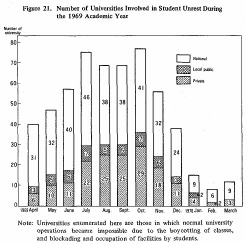| Home > Policy > White Paper, Notice, Announcement > White Paper > EDUCATIONAL STANDARDS IN JAPAN 1971 > CHAPTER |
||
The recent development in higher education has been remarkable. The student unrest during 1968 and 1969, however, has led to increasing criticism of the university system from various circles.
The student unrest is related to various political and social factors. Many of the opinions expressed by protesting students are also related to political problems. Therefore, many of the university problems cannot be solved exclusively within the higher educational system. It cannot be denied, however, that there are also many problems, in the systems of teaching and research, and of administration and management and those these have contributed to student unrest and have made its solution difficult.
Student unrest occurred in connection with student demands for curriculum improvement, withdrawal of raises in tuition fees, self-management of student halls and dormitories, student participation in university administration, withdrawal of student punishments, etc. This coupled with tactics by violent students, such as boycotting classes, blockading and occupying university facilities, informal confinement and impeachment of teachers, in demonstrations aimed at the revocation of the Japan-U.S. Security Treaty and opposition to the Vietnam War plunged the universities into much confusion. In many cases such situations persisted for long periods of time due to inappropriate measures taken by the university authorities and to the fact that there were many sympathizers amongn non-political students and young faculty members.
In October 1969 when student unrest was at its peak, 41 national, 7 local public, and29 private universities were involved. Student unrest occurred more frequently in national universities with comparatively favorable educational conditions than in private universities. Moreover, it persisted for the longest periods of time in those universities with long historical traditions and large student bodies. This implies that there are systemic problems in teaching and research beyond the simple. Provision of teachers, equipment and facilities. It also suggests that it is not easy for old and traditional large-size universities to show university-wide cohesion and to change easily.
As student unrest became intensified and prolonged, public criticism against the student movement increased, and in August 1969, a Law for Provisional Measures Concerning University Governance was enacted. Thereafter, in many universities violence irrespective of ideology was disallowed, and measures were taken to eliminate any violent actions. When it was impossible to do so alone, police were used. Student unrest was thus brought under control.

Note: Universities enumerated here are those in which normal university operations became impossible due to the boycotting of classes, and blockading and occupation of facilities by students.
If the problems pointed out during student unrest are to be solved however, further effort is required to provide curricula which considers the diversification and popularization of higher education, to improve methods of education, and to reform administrative structures in such a way that they may cope with the tendency for universities to become bigger.
Student unrest has also occurred in the U.S., France and West Germany in recent years. Violent actions occurred repeatedly in various forms in these countries. The causes differed according to conditions within each country in general and to respective traditions of higher educational institutions in particular. But common to all was the criticism or opposition of the younger generation directed against established institutions. The manner in which the governments of the respective countries met these situations differed, but the enactment of basic laws concerning higher education, the creation of new systems of teaching and research, and the reform of administrative and managerial structures were some of the measures taken.
| Back to Top | MEXT HOME |